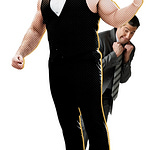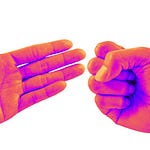What a spectacle! A 70-something-year-old white man commanding the stage as he bellows into a microphone. He holds this packed stadium in thrall to his every utterance. The crowd is in raptures. His crowd. They’ve heard all he has to say before, and they want to hear it all again. They cheer, they chant, and they yell his words back in sync to him.
This is not some tawdry political rally, though, and the man on stage is no bumptious demagogue. He is Bruce Springsteen—“The Boss”—performing at a recent concert I attended. And I can tell you that his reputation as a fantastic showman is solid.
Now I’m no diehard Springsteen fan—much of the setlist was new to me—so, enjoyable as it was, I got to view the show from a different perspective than most. For me, watching The Boss command the stage offered a masterclass in leadership—a how-to of management on a small and grand scale.
But what about that nickname: “The Boss?” It sounds a little overbearing, right? You picture Bruce in a suit slamming his fist down on his mahogany desk, pens and papers flying about the corner office as he chews out another poor underling. As it turns out, Springsteen the performer is just the opposite.
The Boss
On paper, Bruce oversees a massive operation. His E Street Band fills the large stage. There are multiple guitars, a chorus, two percussionists, a horn section, a violin, and the requisite cowbell. The E Street Band is not some mom-and-pop corner store of a rock band. It’s a big-box wholesaler. It’s Costco set to the tune of “The Promised Land.”
At the head of all this is The Boss himself—Bruce Springsteen—musician, songwriter, performer, and entrepreneur. And yes, he literally is the boss. Which is how he got the nickname in the early days when he served as paymaster and decision maker.
But his shows are not some corporatized staging of meticulous choreography and note-for-note precision. Bruce keeps the beat as the heart of a living thing—an organism pumping with raw emotion but focused on a shared endeavor. His small gestures to the band—a nod or wave of the hand—are received as instructions, but with an elation that speaks to a higher purpose. This band has fun, connecting to the crowd and connecting to Bruce—not your typical employer-employee dynamic.
Some members of Springsteen’s band have been rocking with Bruce for decades, so obviously the E Street Band does not suffer from disgruntled workers and high turnover.
These people genuinely seem to like each other and to adore Bruce, responding to him with sheer and infectious joy.
His rapport with the audience is even more energized as performer and spectator feed off each other’s fervor. As with the musicians, some concertgoers have been with him for many decades. Others, just as thrilled to be there, were born decades after his debut album. Everyone yells, “Bruuuuuuce,” between songs and flips out each time he goes to the front of the stage to celebrate with swooning audience members. A few lucky ones get a harmonica or a guitar pick to take home. The bond between artist and fan is cemented in those moments.
Not the Boss
This is where Springsteen’s leadership stands out. Whatever love and adoration there is from the audience and the band, a palpable sense arises that Bruce is already there with them giving it back. The concert I attended was a meeting of equals—musicians, audience, and The Boss. When he finally introduced his E Street Band, there was real pride and delight in his voice. He projected his affection and admiration for these people and his luck at having them at his side. His musical vision—powerful, sophisticated, and authentic—is one they and the audience all share, which is the goal of any leader.
Nearing the end of his three-hour celebration that night when all seemed to be winding down, he gripped the microphone to challenge the crowd: “Do you think you can outlast the E Street Band?” he taunted us. It was a showman’s moment, but it also was a beautiful way to showcase his team’s talents and energy. He didn’t ask, “Do you think you can outlast me?” The focus was on the relationship between the band and the audience with Bruce serving as mere conduit.
The crowd responded wildly to his challenge, which he repeated over and over with this call-and-response lasting several minutes—much longer than one would expect. The goals of this strategy soon revealed themselves. One was, of course, to highlight his musicians. He also was whipping the audience into another frenzy of enthusiasm before we could lag. A third goal was to pull the audience up to his level, inviting us to be part of something greater. And savviest of all, he gave the band a little rest before the final push. That’s leadership!
At long last, it was time for the band to depart. They all took a bow and filed offstage with Springsteen right there to greet them individually, not with a nod or pat but with handshakes and bear hugs and the warmest of smiles as he sent them off. It were as if this concert was not just another stop on the tour but the greatest moment they had shared in all their years together. There was real camaraderie—the kind you could never fake. This wasn’t a bunch of laborers clocking out after a long shift. It was more like a team that had just won the big game. Frankly witnessing it moved me.
But there’s more! Springsteen then took centerstage alone with an acoustic guitar. He strummed idly as he gave an impromptu speech about the good work of a local charity. Who does this? Three hours of nonstop rocking—his white shirt translucent with perspiration on a warm September night—and he offers a heartfelt endorsement and call for donations. He could’ve simply basked in the audience’s adulation. He could’ve sent us out with some heart-pumping hit ringing in our ears. No, he used his platform to shill for a worthy cause before playing a lullaby about dreaming of us. Now there’s a showman, yes, but Springsteen also revealed himself to be a true leader—driven by values— who understands the power of his influence and wields it responsibly!
Bruce Springsteen is no mere boss. He’s a great leader.
The Boss Again
Maybe we should do a little compare and contrast. I’m more of a Bob Dylan fan than a Springsteen fan, so I couldn’t help but reflect on their similarities and differences. Musically the two legends have a lot in common, but their performance and apparent management styles are quite different.
Dylan is an unmatched songwriter whose influence Springsteen has long acknowledged. On stage, though, he often comes across as aloof. His band introductions can be mumbled afterthoughts although he sometimes shows his appreciation with smiles and nods. But there are performances when you can sense a real tension as Dylan casts sharp looks at one or all of them. At those times, the musicians circle Dylan closely, hyper-focused on his every move as though they’re afraid of plunking the wrong chord or hitting the wrong tempo.
To be sure, I’m being unfair to Dylan. He too has loyal fans and works with longtime band members, including a bassist who’s been with him since 1989. And his audiences adore him, but in a very different way from Springsteen’s. Dylan also has a well-earned reputation for reclusiveness that probably has more to do with his core personality than the desire to cultivate an air of distance and mystique, but the effect is much the same. His approach to performance and his aesthetic is distinct from most rock musicians’. He does not reach out to swoop up the audience so much as he sets a musical marker for them to aspire to.
The feel is totally different with Springsteen. Bruce regularly highlights individual musicians by calling them to the front of the stage to interact and solo. His affection and pride are apparent as they perform together. He might even give them a heartfelt squeeze around the shoulders when they’re done. While Dylan challenges and urges the audience to reach his heights, Springsteen scoops the audience into one of those warm bear hugs, and they embrace him back.
Great Leadership = Great Performance
It all comes down to what it means to be “the boss.” In the traditional sense, it’s fairly easy. Just throw your weight around, keep your distance, and snap people into place. What we see from Springsteen, though, is far more challenging. Instead of forging a world where everything and everybody is about him, he creates a culture of collaboration where each individual—musician, concertgoer, and even crew member—is invested in the success of his artistic vision.
That’s true leadership!
If you’re not a rockstar, what does all this mean? In any field, we can see the positive effect of being a leader rather than a mere boss. Leaders act like Springsteen. They roll up their sleeves and get to work with their people, celebrating team successes and learning from failure. Everyone knows their part in the mission and plays it with exuberance.
Bruce transcends that old moniker, “The Boss.” He’s no longer the master of pay and task. He’s the opposite—the stuff that holds his venture together. To attend a Springsteen concert is to see great leadership unfold in real time. In our world—one that glorifies cutthroats as they climb to the top—Springsteen reminds us that true leaders raise others up alongside them.
He’s a great performer because he’s a great leader. Think about that.
So, why be a mere boss when you can emulate “The Boss,” Bruce Springsteen himself? Sure, it takes more effort and smarts, but Bruce and the E Street Band sure seem to be having a ball. And if thousands of people whipped into a three-hour frenzy of music, enthusiasm, and—yes—joy is any indicator, it’s a whole lot more powerful too.
How conscious are you of the distinction between a boss and a leader? What do you do to assure you’re serving as a leader rather than a mere boss?
It takes guts and resilience to embrace the challenge of great leadership, and I can help.
Unlock the Great Leader Within! Download my free resource, the Transform To GREATness Toolkit, now!
I look forward to hearing from you.
Intro and outro podcast theme music by LiteSaturation from Pixabay.
Check out these pages to invite me speak at your event or appear on your podcast:
Check out my Speaker’s Page
Check out my Podcast Guest Page


















Share this post